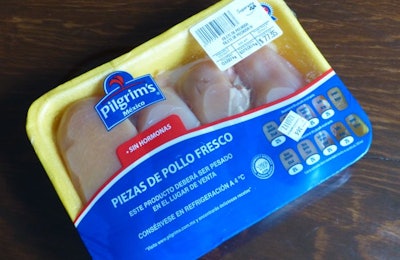
Broiler producers in Mexico have for a long time been unable to overcome the fluctuations of the market. According to some producers, it is due to the growing volumes of chicken imported from the United States and Brazil.
“We are helpless against this,” said a poultry producer in an interview at the International Production & Processing Expo (IPPE) held two weeks ago.
According to this poultry producer, it is estimated that 540,000 metric tons (MT) of chicken from the United States and Brazil have entered the country in one year. The latter contributes with almost 20% of this amount, mainly breast meat. “More or less, 70% of the chicken sold in supermarkets without brand name comes from imports,” he said.
At the National Poultry Producers Association (UNA), Arturo Calderón, executive president, said in an interview with Industria Avícola that it is attributed to the fact “that there is [chicken] oversupply, because there has been no drop in consumption.” On the contrary, with the lower price, Mexican consumers will favor chicken more.
“Poultry producers are doing things right. The productivity levels are correct,” the UNA executive president added. However, “the other issue is that we are open to imports and unfortunately there may still be people who are importing.”
Sufficient chicken supply
A few days ago, the Undersecretary of Industry, Commerce and Competitiveness, Ernesto Acevedo, reported in other media that “chicken meat supply is enough to meet the national consumption needs of chicken.” Without a doubt, if the supply was insufficient, the prices would not be so low.
He stressed that “prices of this product show some stability and even, they behave slightly better than general inflation,” as measured by the General Consumer Price Index.
Consumption and imports
In the same source mentioned above, Acevedo said that in Mexico, “about four million MT of chicken are consumed per year, of which, practically 86% comes from domestic production.”
Making up the remainer is 12% representing U.S. imports -- mainly leg quarters -- and the other 2%, which amounts to less than 100,000 metric tons per year, comes from Brazil (breast and wings) and Chile, according to Acevedo.
With respect to chicken from Brazil and other countries that do not have a free trade agreement with Mexico, the quota was filled at the end of last year. “Fortunately, the Ministry of Economy has not expanded it,” said Calderón. Unfortunately, there is no sign of what the Ministry of Economy will do, but the expectation is that it will not happen. “There are no signs that the Ministry of Economy will open more quotas to Brazil and hopefully so.”
With regard to imports from other countries, such as Chile, at the time of the interview they still did not have any official statistics to know what happened.
According to the Undersecretary of Industry, Commerce and Competitiveness, chicken production in the country grew in 2019 at a rate of 4.2%.
Prospects for the future
Some poultry producers have reported production costs of MXN19/kg (US$1.02/kg), while live sales have been around MXN13 (US$0.70/kg), which is a very widespread. Future perspectives do look complicated.
“We do not know when it will stop,” said the UNA official. There have been small variations over the past few months, but it is not known how much longer this situation can last.
The chicken price curve in Mexico must be observed over time. In all the months of January, it is always when prices are lower.
“Although at the beginning of the year, prices are relatively lower, perhaps this year they are even lower.” The problem is that many situations now converge, unfortunately for poultry producers.
The whiplash effect of the United States
To aggravate the situation, prices in the United States are also very low. It is not an exclusive situation to Mexico. All this adds up to explain what it is happening.
Tyson Foods, according to a Wall Street Journal (WSJ) report, cited price drops in the U.S., due to an increase in broiler population, which has affected the company’s profits. And it is not only the population, but also the fact that birds are heavier, which has added to the abundance of meat.
The factors that can positively impact, according to the WSJ, is the possible increase in imports of chicken from China in the presence of African swine fever (ASF), drought in Australia that has affected livestock, and finally the battle that is being fought in United States over which restaurant has the best chicken sandwiches.
But beware, the USDA expects a 4% increase in chicken production this year in the United States.


















